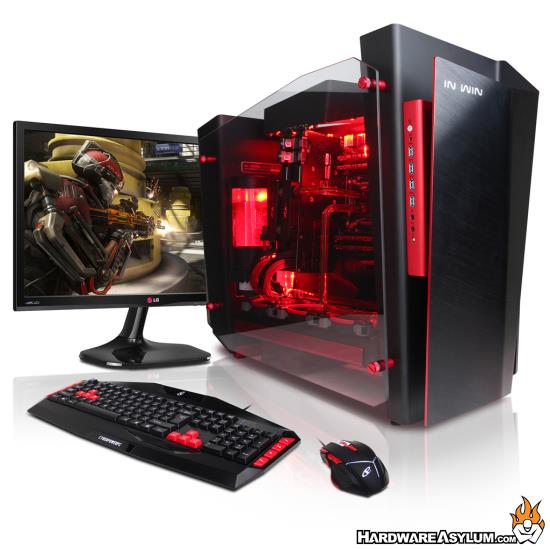Tech News
-
When it comes to overclocking, This is what we need!
When I wrote my article about how Overclocking Competitions needed to change (Overclocking Competitions: About the Player not the Hardware) I used Professional Golf as an analogy to setup the new competition style. I did this because it is a great parallel with a proven formula that works for everyone involved.
Players with skill get paid
Spectators understand what is happening and are engaged
Commentators are given something to talk aboutThe final part to the formula is the Manufacturer and Sponsor since they build the gear they need to get a return on their investment and this is how they do it. (well one of many ways)

As they used to say in NASCAR, "What wins on Sunday sells on Monday" and Taylormade has taken this to heart. Jason Day won the PGA Championship on Sunday August 16th who happens to be a Taylormade sponsored player. With his win Taylormade published his gear so that everyone knows what clubs he used to win the tournament at 20 under.
If we draw the parallel against Overclocking when a factory supported overclocker wins a competition the sponsor can do the same thing. For instance maybe it was a 3D benchmark that sealed the competition so, why not highlight that product and tell everyone where they can buy it.
Sky is the limit people.
-
EK-FC Titan X (Original CSQ) GPU block @ HardwareOverclock
Most sites are hitting skylake pretty hard from basic, "hey how you doing?", to "OMG the TIM...". Don't get me wrong, Skylake is the news of the month but that isn't all that is happening. Take this review for instance.
It isn't about Skylake or a GTX 980Ti (almost).
HardwareOverclock.com has just posted another review. Last week we have take a look at the EK-FC Titan X (Original CSQ) GPU block. EK-FC Titan X is a high performance full-cover water block for nVidia reference (NVA-PG600) design GeForce GTX Titan X and GTX 980 Ti series graphics cards. We have tested the cooler on a GTX 980 Ti reference card.
TitanX reference waterblock FTW. Don't mind the "not" English in the review, we go there for the photos.
-
Going-Out-Of-Business Sign Thanks Neighborhood For 3 Months Of No Support Whatsoever
You have to love the Onion for coming up with some pretty amazing stuff. In this case the letter looks legit so maybe props to the cafe owner?.

INDIANAPOLIS—Shuttering its doors after an unprofitable 12 weeks in business, local coffee shop Crossroads Café offered a heartfelt goodbye to the community this week with a large going-out-of-business sign thanking residents for their total lack of support.
Click the link to read the letter.
-
Zotac GTX 980 Ti AMP! Extreme – The fastest 980 Ti available? @ Bjorn3d
I'm not sure if this is the "fastest" 980Ti but it sure is up there.
The GTX 980 Ti is not only a fast GPU but also a GPU that overclocks extremely well. This means that few cards for sale actually are running at reference speeds, 1000 Mhz, and instead are overclocked at different levels. Zotac are no strangers to overclocking usually offering a wide variety of cards for each generation. Their AMP!-edition cards not only are overclocked but come with their own special cooler and thus when we got a question whether we wanted to review one of their GTX 980 Ti AMP!-cards we jumped to the chance, especially as it turned out to be the Zotac GTX 980 Ti AMP! Extreme-card. With a base core clock of 1253 MHz, 25.3% higher than a reference GTX 980 TI, this is so far the highest clocked GTX 980 Ti we’ve seen from any OEM. And just to whet your appetite, the card even overclocks further! Add to that 6 GB of DDR5 memory running at 7220 MHz (up from 7010 MHz) and a special silent tri-fan cooler (IceStorm – love the names) and it is clear that this on paper is the “king of GTX 980 Ti”
I have a review of the EVGA GTX 980Ti Classified coming out next week so we shall see which is the fastest of them all.
Of course it would help with an "actual" sample of the Zotac but them is difficult to get.

-
CYBERPOWERPC Updates Gaming PC Lineup Launches New Luxe Series Gaming PCs
CITY OF INDUSTRY, CA (August 5, 2015) – CyberPower Inc., www.cyberpowerpc.com, a global manufacturer of custom gaming PCs, gaming laptops, and performance workstations, today announced the immediate availability of 6th Generation Intel® Core™ processors for enthusiast desktop PCs– the Intel® Core™ i5-6600K and Intel® Core™ i7-6700K.
The newest Intel Core i5-6600K and Intel Core i7-6700K enthusiast desktop processors and companion Intel® Z170 Chipset chipset will be featured across CYBERPOWERPC’s award winning systems including the Gamer Xtreme series, Fang III, Zeus EVO, and more. For those looking at smaller form factors, the Fang Mini and Zeus Mini systems equipped with the new Intel processors will be available shortly after launch. The desktop systems are available today at the CYBERPOWERPC web site and from the company’s online partners such as Newegg, Amazon, Walmart, Bestbuy, TigerDirect, and many more online retailers.
The latest 6th Generation Intel Core desktop processors for gamers and enthusiasts feature new CPU microarchitecture, improved graphics engine, support for DDR3L and DDR4 memory and substantially lower power consumption. The Intel Core i7-6700K CPU, features a quad core design with eight threads with a multi-threaded design. The chip features 8 MB of L3 cache and has clock speeds 4.0GHz. The Intel Core i5-6600K is a quad core CPU that still maintains a clock speed at 3.5 GHz and Intel’s Turbo Boost 2.0 technology that can overclock the CPU up to 3.9GHz.
“We are extremely excited CyberPower will bring new gaming PCs to market using the Intel® Core™ i7-6700K & i5-6600K processors and Intel® Z170 chipset to customers in order to deliver an amazing desktop gaming experience,” said Laura Crone, Intel Vice President and General Manager, Channel Platforms and Operations “The power of 6th Generation Intel Core inside CyberPowerPC’s award winning gaming PCs is a great combination.”

CYBERPOWERPC systems built with the new 6th Generation Intel Core enthusiast processors and Intel® Z170 Chipset feature Intel Rapid Storage technology for PCI Express storage with support for M.2 x4 and SATA Experess x2 connectors; support for up to 10 USB 3.0 ports (14 total); up to 20 PCI Express 3.0 lanes; 2X DMI bandwidth increase of prior generation and 6 SATA 3.0 ports to provide acceleration and headroom for a variety of tasks including video encoding and gaming.
CYBERPOWERPC systems based on the Intel Core i5-6600K processor will start under $790. The Intel Core i5-6600K gaming system includes:
- CPU Intel Core i5-6600K Quad-Core CPU
- Motherboard Intel Z170 Chipset based motherboard
- NVIDIA GeForce GTX 750 1GB
- Memory 8GB
- HDD 1TB 7200RPM HDD
- Cooling Asetek 550LC Liquid Cooling
- Microsoft Windows 8.1
Coinciding with the launch of Intel 6th Generation Core processors, CYBERPOWERPC is also set to launch a new ultra-high-end gaming PC series called the Luxe series. The new Luxe series features the In-Win S-Frame aluminum chassis with tempered glass side panels.
Accompanying the svelte chassis is a new custom liquid cooling setup – CYBERPOWERPC’s Hydroluxe hard-tube liquid cooling with 240mm or 360mm options. The acrylic hard tube setup makes the Luxe series shine over other gaming PCs and the D5 pump & reservoir setup ensures cool operations. The Luxe series features both 6th Gen Intel Core processor setups and 5th Gen Intel Haswell-E based configurations.
The Luxe series has a starting price of $2769 for 6th Gen Intel Core i5 or $2,879 for the Core i7 variant. CYBERPOWERPC Luxe series include: CYBERPOWERPC Hydrofluxe hard-tube liquid cooling, NVIDIA GeForce GTX Liquid Cooled video cards – including GTX 980, 980 Ti, and Titan X models.
All CYBERPOWERPC gaming desktop can be custom configured with a number of hardware options, including high-performance gaming memory, solid state drives, graphics cards, and gaming peripherals. Fully-assembled desktop systems from CYBERPOWERPC include an industry-leading 3-year limited warranty. For more information, see http://www.cyberpowerpc.com.
-
SteelSeries QcK XXL Gaming Mousepad Review @ Legit Reviews
Back in the day, hardware review ment more than exciting stuff like top end video cards and super fast storage systems. In fact things were a little more down to earth when external hard drive enclosures were "all the rage" and the latest card reader consumed all of the front page news.
It is good to see that Legit Reviews hasn't forgotten those days with their review of the SteelSeries QcK XXL Gaming Mousepad. The thing is pretty big and likely produced in response to the Aorus Thunder P3 Gaming Mousepad that we reviewed almost a year ago.
I’m sure gamers can relate to at least one experience with a mousepad that isn’t large enough; an annoying and sometimes unpleasant feeling when the mouse goes somewhere it shouldn’t. Fortunately, there are so-called gaming mousepads and they’re actually nice to have. Their characteristic large size offers an ample surface and forgiving space for a gamer’s mouse movements, compared to the more typical mousepad that might be smaller than a dinner plate. What we have for review here is an exaggeration of that end to the need. I’m sure some people have some fair use for the QcK XXL, SteelSeries newest and largest mousepad ever released. Measuring 900 by 400 mm (35.4 by 15.7 in), this nearly 3 foot long cloth surface can fit more than a mouse and keyboard.
Big pads mean big money, makes you wonder if anyone has figured out how to wash them.

-
Corsair Obsidian Series 750D Airflow Series Review @ [H]
Big and Badass Black. Seems like a good combo?
It's big. It's black. In fact it's "Obsidian!" Corsair's new 750D computer case is actually all steel and brushed aluminum, not volcanic rock. Corsair's take on the 750D Airflow Series is that it is easy to build in and has all the features you need rather than a plethora of bells and whistles that only look good on a spec sheet.
This has actually been a very popular case for Corsair, very classic styling, good airflow and reasonably priced. Of course, aggressive marketing helps along with a total "fall on your face" from both TT and CM.

-
EVGA and K|NGP|N Set New 3DMark World Records
Some big news today from EVGA!
July 29th, 2015 – EVGA has once again raised the bar with three new 3DMark Single Card World Records. Armed with liquid nitrogen cooling, an EVGA X99 motherboard, EVGA high performance Power Supplies, an EVGA GeForce GTX 980 Ti K|NGP|N graphics card running at over 2GHz and EVGA PrecisionX 16 overclocking software, Vince “K|NGP|N” Lucido was able to reach new heights in 3DMark Fire Strike, Fire Strike Extreme and Fire Strike Ultra presets.
3DMark Fire Strike = 25,233
3DMark Fire Strike Extreme = 13,091
3DMark Fire Strike Ultra = 6,988
These new World Records show EVGA’s commitment to the enthusiast with unparalleled high performance products and software. Learn more about the EVGA GeForce GTX 980 Ti K|NGP|N graphics card here: http://www.evga.com/articles/00944/EVGA-GeForce-GTX-980-Ti-KINGPIN/
About 3DMark Fire Strike
Fire Strike is a showcase DirectX 11 benchmark designed for today's high-performance gaming PCs. It is one of the most ambitious and technical benchmarks ever, featuring real-time graphics rendered with detail and complexity far beyond what is found in most benchmarks and games today.About EVGA
EVGA is the #1 NVIDIA authorized partner in channel sales throughout North America and UK. Based on the philosophy of intelligent innovation, market knowledge, and the real time operation, EVGA continues to identify the need in the market place and providing the solution to that need. By offering product differentiation, 24/7 tech support, a 90 day Step-Up program, and other customer focused programs, EVGA is a clear leader in all categories: etail, retail, distribution, and system integration. With headquarters in Brea, CA, EVGA’s global coverage includes EVGA GmbH in Munich, EVGA LATAM in Miami, and EVGA Hong Kong. For further information online about EVGA, visit: www.evga.com -
ASRock X99 OC FORMULA/3.1 (Intel LGA 2011-3) @ techPowerUp
OMG, the GOLD!!
Actually AsRock OC motherboards have always been Yellow/Gold so I'm not sure why I am surprised.

ASRock's updated X99 OC FORMULA is here, now called the ASRock OC FORMULA/3.1. Fitted with the latest in USB technology, the ASRock X99 OC FORMULA/3.1 is ASRock's top-level overclocking board built to smash clock records time and again. USB 3.1 isn't everything: we've got SATA Express, Ultra M.2, Xeon, and ECC support - every high-speed item you could ask for when overclocking X99 is here.
The motherboards come packed in foam and "should" still have the conformal coating however, based on the photos I'm not seeing signs of it anymore. I guess the added expense finally caught up to them.
-
GIGABYTE X99 SLI Review, Excellence On A Budget! @ Bjorn3d
Budget is everything when it comes to building a PC and what if you can get "Excellence" and not break the budget?
Seems like a good combo.
GIGABYTE has released an entire pack of motherboards based on the Intel X99 chipset: Champion, Gaming, and Super Overclock. And now GIGABYTE has released the X99-SLI board. From the first glance, the board looks to be chock full of enthusiast-level hardware, with lots to offer most end users. To field the board with all that high-end hardware at $250 (NewEgg) , they had to make a few compromises, but based on price/performance, there’s a good bang for the buck factor on the GIGABYTE GA-X99-SLI.
I really like what Gigabyte did with their last round of X99 motherboards. Sure, there could have been some things "done better" but they did get the budget part of the equation sorted.

